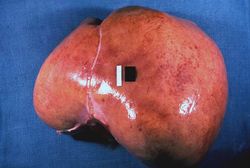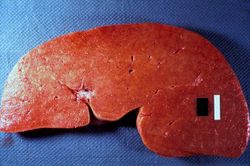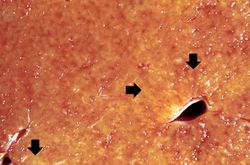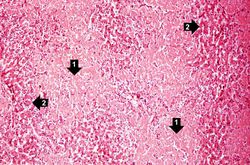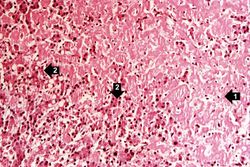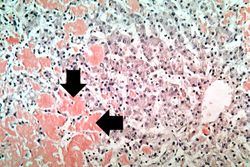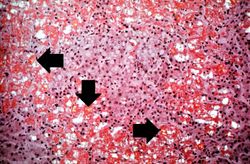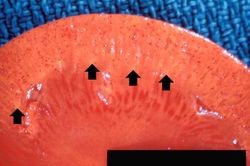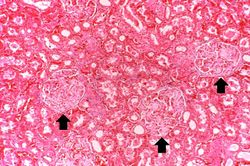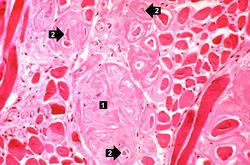Difference between revisions of "IPLab:Lab 6:Amyloidosis"
Seung Park (talk | contribs) (→Images) |
Seung Park (talk | contribs) |
||
| Line 19: | Line 19: | ||
File:IPLab6Amyloid11.jpg|This photomicrograph of the tongue demonstrates extensive amyloid deposits (1) separating the skeletal muscle fibers of the tongue. In many cases the amyloid encircles the muscle fibers (2) and these muscle fibers are atrophied. | File:IPLab6Amyloid11.jpg|This photomicrograph of the tongue demonstrates extensive amyloid deposits (1) separating the skeletal muscle fibers of the tongue. In many cases the amyloid encircles the muscle fibers (2) and these muscle fibers are atrophied. | ||
</gallery> | </gallery> | ||
| + | |||
| + | == Virtual Microscopy == | ||
| + | <peir-vm>IPLab6Amyloid</peir-vm> | ||
== Study Questions == | == Study Questions == | ||
Revision as of 16:20, 3 January 2014
Contents
Clinical Summary[edit]
This 46-year-old white male with a long-standing history of rheumatoid arthritis was admitted for treatment of pneumonia. Subsequently, complications associated with lung abscesses, empyema, and septicemia led to the patient's death.
Autopsy Findings[edit]
The liver weighed 2600 grams. It was yellowish-tan in color and cut with difficulty (fibrosis?). No other pathological changes were noted except for pneumonia and lung abscesses.
Images[edit]
This is a gross photograph of kidney from this case. Note the pale yellow material within the cortex (arrows). This is indicative of amyloid within the cortex and the glomeruli. Also note that there are multiple red spots in the cortex. These represent congested glomeruli due to the vascular compromise produced by the amyloid.
Virtual Microscopy[edit]
Study Questions[edit]
Additional Resources[edit]
Reference[edit]
- eMedicine Medical Library: Amyloidosis
- eMedicine Medical Library: Amyloidosis, AA (Inflammatory)
- Merck Manual: Amyloidosis
Journal Articles[edit]
- Obici L, Merlini G. AA amyloidosis: basic knowledge, unmet needs and future treatments. Swiss Med Wkly 2012 May 31;142:w13580.
Images[edit]
Related IPLab Cases[edit]
In alcoholics, aspiration pneumonia is common--bacteria enter the lung via aspiration of gastric contents.
An abscess is a collection of pus (white blood cells) within a cavity formed by disintegrated tissue.
A normal liver weighs 1650 grams (range: 1500 to 1800 grams).
